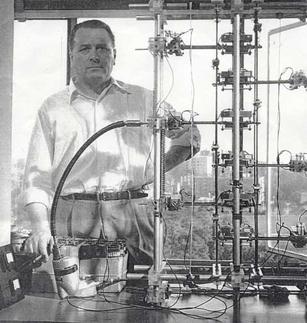
Silicon Forest is a Washington County cluster of high-tech companies located in the Portland metropolitan area in the U.S. state of Oregon. The term most frequently refers to the industrial corridor between Beaverton and Hillsboro in northwest Oregon. The high-technology industry accounted for 19 percent of Oregon's economy in 2005, and the Silicon Forest name has been applied to the industry throughout the state in such places as Corvallis, Bend, and White City. Nevertheless, the name refers primarily to the Portland metropolitan area, where about 1,500 high-tech firms were located as of 2006.
A review is an evaluation of a publication, product, service, or company or a critical take on current affairs in literature, politics or culture. In addition to a critical evaluation, the review's author may assign the work a rating to indicate its relative merit.

The Dean drive was a device created and promoted by inventor Norman Lorimer Dean (1902–1972) that he claimed to be a reactionless drive. Dean claimed that his device was able to generate a uni-directional force in free space, in violation of Newton's third law of motion from classical physics. His claims generated notoriety because, if true, such a device would have had enormous applications, completely changing human transport, engineering, space travel and more. Dean made several controlled private demonstrations of a number of different devices; however, no working models were ever demonstrated publicly or subjected to independent analysis and Dean never presented any rigorous theoretical basis for their operation. Analysts conclude that the motion seen in Dean's device demonstrations was likely reliant on asymmetrical frictional resistance between the device and the surface on which the device was set, resulting in the device moving in one direction when in operation, driven by the vibrations of the apparatus.

Quatama, formerly Quatama/Northwest 205th Avenue, is a light rail station in Hillsboro, Oregon, United States, that is served by TriMet as part of the MAX Light Rail system. Situated between Orenco station and Willow Creek/Southwest 185th Avenue Transit Center, it is the seventh eastbound station on the Blue Line and the fourth eastbound station on the Red Line. The two-track, island platform station includes a park-and-ride lot. Quatama Station is named after the area which includes Quatama Road to the south of the station. Opened in 1998, the stop is near high-tech industries and the Amberglen business park, which includes Oregon Health & Science University's West Campus and the Oregon National Primate Research Center. With the renaming of Northwest 205th Avenue to Northeast John Olsen Avenue by the city of Hillsboro in 2017, TriMet changed the station's name from its original, longer name.
Etec Systems was an American producer of scanning electron microscopes, electron beam lithography tools, and laser beam lithography tools from 1970 until 2005. It was located in Hayward, California, and Hillsboro, Oregon.

Century High School (CHS) is located in Hillsboro, Oregon, United States.
A vibrator is a mechanical device to generate vibrations. The vibration is often generated by an electric motor with an unbalanced mass on its driveshaft.
Mechanical screening, often just called screening, is the practice of taking granulated or crushed ore material and separating it into multiple grades by particle size.

Digital marketing is the component of marketing that uses the Internet and online-based digital technologies such as desktop computers, mobile phones, and other digital media and platforms to promote products and services.

Precision Castparts Corp. is an American industrial goods and metal fabrication company that manufactures investment castings, forged components, and airfoil castings for use in the aerospace, industrial gas turbine, and defense industries. In 2009 it ranked 362nd on the Fortune 500 list, and 11th in the aerospace and defense industry. In 2015 it ranked 322nd overall and 9th in the aerospace and defense industry. In 2014 it ranked 133rd on the S&P 500 based on market capitalization. In January 2016, the company became a wholly owned subsidiary of Berkshire Hathaway. Before that event, it used to be one of the three Fortune 500 companies headquartered in Oregon.

The Hillsboro Argus was a twice-weekly newspaper in the city of Hillsboro, Oregon, from 1894 to 2017, known as the Washington County Argus for its final year. The Argus was distributed in Washington County, Oregon, United States. First published in 1894, but later merged with the older, 1873-introduced Forest Grove Independent, the paper was owned by the McKinney family for more than 90 years prior to being sold to Advance Publications in 1999. The Argus was published weekly until 1953, then twice-weekly from 1953 until 2015. In early 2017, it was reported that the paper was planning to cease publication in March 2017. The final edition was that of March 29, 2017.

FEI Company was an American company that designed, manufactured, and supported microscope technology. Headquartered in Hillsboro, Oregon, FEI had over 2,800 employees and sales and service operations in more than 50 countries around the world. Formerly listed on the NASDAQ, it is now a subsidiary of Thermo Fisher Scientific.

DeMarini Sports, Inc. is an American manufacturer of sports equipment headquartered in Hillsboro, Oregon, United States. The company is known for producing baseball and softball bats and batting gloves. They are known for bats such as the “CF” and the “Voodoo One”.
Whole body vibration (WBV) is a generic term used when vibrations (mechanical oscillations) of any frequency are transferred to the human body. Humans are exposed to vibration through a contact surface that is in a mechanical vibrating state. Humans are generally exposed to many different forms of vibration in their daily lives. This could be through a driver's seat, a moving train platform, a power tool, a training platform, or any one of countless other devices. It is a potential form of occupational hazard, particularly after years of exposure.

The Hillsboro Police Department (HPD) is the municipal law enforcement agency of the city of Hillsboro, Oregon, United States. It is a regionally accredited agency with 127 sworn officers on the force. The chief is Jim Coleman in a city of over 110,000 residents west of Portland, Oregon, in Washington County. With 169 employees as of 2014, the department is the second largest police force in the county and seventh largest in Oregon.

TriQuint Semiconductor was a semiconductor company that designed, manufactured, and supplied high-performance RF modules, components and foundry services. The company was founded in 1985 in Beaverton, Oregon, before moving to neighboring Hillsboro, Oregon. In February 2014, Greensboro, North Carolina–based RF Micro Devices and TriQuint announced a merger in which the new company would be Qorvo, Inc., with the merger completed on January 1, 2015.

Social media marketing is the use of social media platforms and websites to promote a product or service. Although the terms e-marketing and digital marketing are still dominant in academia, social media marketing is becoming more popular for both practitioners and researchers.
Feonic is a commercial company specialising in the design and development of magnetostrictive audio products.

The Nike Sport Research Lab is a research and development institute located in Beaverton in the U.S. state of Oregon. Opened in 1980, the lab is owned by American apparel and footwear maker Nike. Commercials for the facility have featured famous NBA and PGA athletes talking positively about the products and the research behind them.
Acumed, LLC is a privately owned medical device manufacturer based in Hillsboro, Oregon in the Portland metropolitan area of the United States. Founded in 1988, the company employs nearly 500 people domestically and internationally who design, manufacture, and market orthopedic implants and surgical devices. The company is a subsidiary of Colson Associates, a spin-off of the Marmon Group, a Berkshire Hathaway company.












